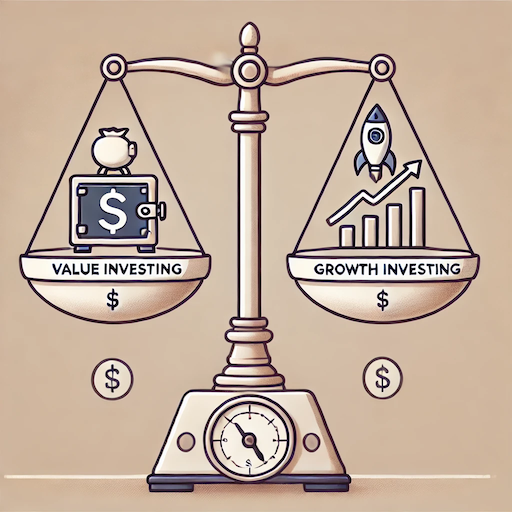- Published on
Value Investing vs Growth Investing: What's Your Investment Strategy?

Comparison of Representative Value and Growth Investors
| Characteristic | Warren Buffett (Value) | Philip Fisher (Growth) |
|---|---|---|
| Analysis Method | Quantitative Analysis Focus | Qualitative Analysis Focus |
| Investment Target | Undervalued Quality Companies | Companies with High Growth Potential |
| Investment Period | Ultra Long-term | Long-term |
| Portfolio | Diversification | Concentrated Investment |
| Key Indicators | P/E, P/B, Dividend Yield | Revenue Growth Rate, R&D Investment Ratio |
| Risk Management | Securing Margin of Safety | Thorough Company Analysis |
Value Investor: Warren Buffett
Warren Buffett is a representative figure of modern value investing. His investment philosophy and strategy are as follows:
Intrinsic Value Analysis: Buffett comprehensively analyzes a company's financial statements, management capabilities, and market competitiveness.
Long-term Holding: He prefers a strategy of finding good companies and holding them for long periods.
Margin of Safety: He minimizes risk by buying at a price lower than the company's intrinsic value.
Understandable Business: He only invests in companies with business models he can understand.
Dividend Focus: He prefers companies that pay stable dividends.
Growth Investor: Philip Fisher
Philip Fisher is known as a pioneer of growth investing. His investment philosophy and strategy are as follows:
Focus on Qualitative Analysis: He places more importance on growth potential, management capabilities, and R&D capacity than on financial statements.
Scuttlebutt Approach: He collects information from various sources to analyze companies.
Concentrated Investment: He prefers a strategy of concentrated investment in a small number of quality companies.
Long-term Holding: He holds growth companies for long periods until their potential is fully realized.
Innovation Focus: He prefers companies that continuously invest in innovation and R&D.
Value Investing vs Growth Investing
| Sector | Value Stock | Growth Stock |
|---|---|---|
| Technology | IBM | NVIDIA (NVDA) |
| Consumer | Coca-Cola (KO) | Amazon (AMZN) |
| Finance | JPMorgan Chase (JPM) | Square (SQ) |
| Healthcare | Johnson & Johnson (JNJ) | Moderna (MRNA) |
| Communication | AT&T (T) | Netflix (NFLX) |
Stock Descriptions:
Technology Sector:
- IBM (Value): A traditional tech company providing stable earnings and dividends.
- NVIDIA (Growth): An innovative company showing rapid growth in AI and graphics processing.
Consumer Sector:
- Coca-Cola (Value): A global beverage company with stable cash flow and high dividend yield.
- Amazon (Growth): A company showing continuous growth in e-commerce and cloud computing.
Finance Sector:
- JPMorgan Chase (Value): A large bank providing stable earnings and high dividends.
- Square (Growth): A rapidly growing company offering innovative payment solutions in the fintech sector.
Healthcare Sector:
- Johnson & Johnson (Value): A stable company offering various pharmaceuticals and consumer health products.
- Moderna (Growth): An innovative vaccine development company based on mRNA technology with high growth potential.
Communication Sector:
- AT&T (Value): A large telecom company providing stable earnings and high dividend yield.
- Netflix (Growth): A company showing continuous growth in the streaming service sector.
Which Strategy Should You Choose?
Value investing and growth investing are not mutually exclusive concepts. Many successful investors appropriately mix the two strategies.
When Value Investing is Suitable:
- When you want stable returns
- When you want to build a portfolio with low volatility
- When you prefer long-term investment
When Growth Investing is Suitable:
- When you pursue high returns
- When you're interested in new technologies and trends
- When you can tolerate high risk
Conclusion: A Balanced Approach is Key
Both value investing and growth investing have their pros and cons. For successful investing, you need to choose an appropriate strategy considering your investment goals, risk tolerance, and investment horizon.
Many experts advise that mixing the two strategies appropriately is most effective. For example, investing part of your portfolio in stable value stocks like IBM, Coca-Cola, Johnson & Johnson, and the rest in companies with high growth potential like NVIDIA, Amazon, Moderna.
Ultimately, the most important thing is continuous learning and market analysis. Developing your own investment philosophy and the ability to flexibly respond to market conditions is the key to long-term investment success.
Keep learning and growing in your investment journey. We hope your investments bear fruit!